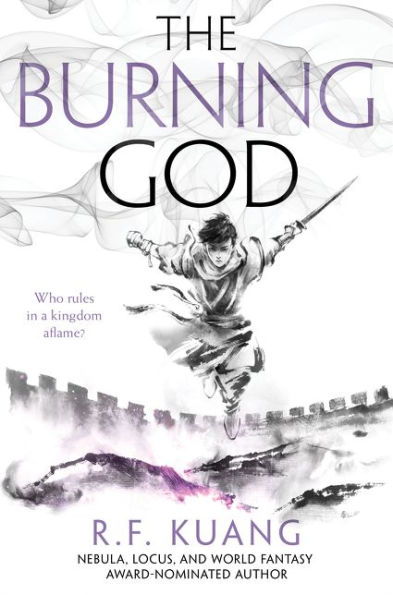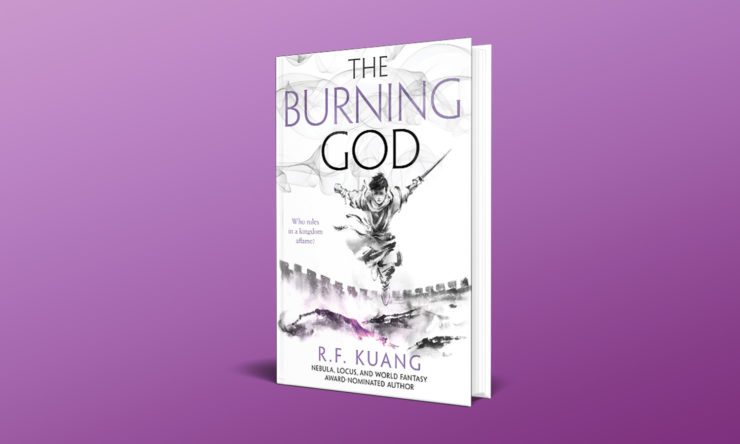We start The Burning God, the last book in R. F. Kuang’s Poppy War trilogy, at the beginning of a battle. It’s an appropriate start for a trilogy rife with war. And though the sides have changed—Rin is now the head of the Southern Coalition after she was imprisoned by the Republic she once fought for—the brutal nature of warfare remains the same.
This unrelenting toll of battle, like in the two books before it, remains an overarching theme in The Burning God. In war, those with power commit horrific acts, justifying it as a necessary evil to achieve their ultimate aims. Both sides are often corrupted in this way, and Kuang makes sure to remind us that our protagonist, Rin, is no exception.
Rin is far from a pious do-gooder. She is driven throughout the trilogy by vengeance; vengeance at first against the Mugenese, who wiped out her people, and then against her former rival-turned-friend Nezha, who leads the Republic she once fought for. Her vengeance has given her power—it’s why the Phoenix god was able to give her control over fire–but it has also corrupted her to the point where, at the beginning of The Burning God, she decides burning dozens of civilians to death is worth it if it means she’ll also kill the Mugenese troops trapped with them.
Without spoiling too much, it’s fair to say that things get darker from there. There’s nary a silver lining to find in The Burning God’s 560 pages, and those looking for a lighthearted book won’t find it here. What readers will get, however, is a gut-wrenching ride, especially for those who have come to care for Rin, Kitay, Venka and the other characters Kuang has created.
Buy the Book


The Burning God
That is one of the strengths of The Poppy War books—they are at least as much about the characters as they are about the ramifications of war. Kuang, for example, is able to make us care about Rin even as she commits unforgivable atrocities. And we also sympathize with Nezha, who Rin now considers her enemy.
We learn more about Nezha’s past in The Burning God, which gives him extra depth we didn’t have in The Poppy War and The Dragon Republic. Through these flashbacks, we come to better understand why he makes the choices he did at the end of The Dragon Republic, and why he’s staying loyal to the Republic.
That’s another theme of the trilogy–people are shaped by their circumstances, and no one thinks of themselves as the villain. There is no equivalent of Sauron in this series, although the Hesperians, who are clearly the trilogy’s rendition of this world’s Western culture, make a fighting chance of it. But even the Hesperians have their sympathetic characters, such as the well-meaning-yet-very-racist young priest in The Dragon Republic.
Who is right and who is wrong is often (often, but not always) muddled in The Poppy War trilogy, and The Burning God is no exception to this. The book, however, goes beyond exploring the moral ambiguity war creates to ask whether it even matters who is ultimately right or victorious, if all that’s left at the end is death and devastation. It’s a question that different characters have different answers to, with unsurprisingly tragic results.
And so we follow Rin as she continues to fight through the civil war, her path crosses with several characters we’ve seen in the first and second book, from the Trifecta, to Chagan, to even the Pirate Queen, Moag.
Without getting too much into spoiler territory, it’s fair to say that the end is tragic. The end, however, also holds a kernel of hope for the future. Whether that hope will be rewarded is uncertain. What is certain, however, is that Kuang has crafted a story that is truly epic in nature, making this trilogy one of the best epic fantasies of the past decade.
The Burning God is available from Harper Voyager.
Read an excerpt here.
Vanessa Armstrong is a writer with bylines at The LA Times, SYFY WIRE, StarTrek.com and other publications. She lives in Los Angeles with her dog Penny and her husband Jon, and she loves books more than most things. You can find more of her work on her website or follow her on Twitter @vfarmstrong.










